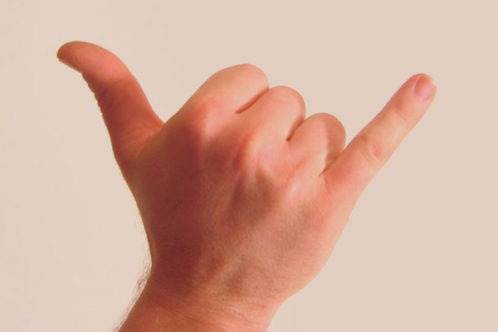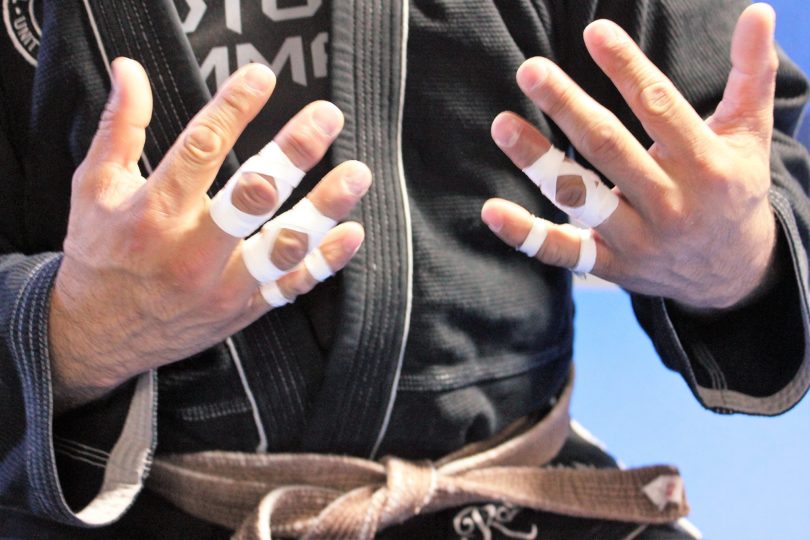
Finger tape solves everything – or so we’ve bn told. I’m most definitely one of those people that are on the finger tape bandwagon. In fact, just last night in training a new student noticed that I only had two fingers that were not wrapped. That was at the start of class. By the end, I was left with only one. And that’s not the worst of it. In BJJ hands are used more than any other body part, although we hardly ever recognize that as important. Particularly when it comes to Gi JIu-JItsu, injuries happen not only to the fingers but every part of the had. And yeah, as innocuous as they might seem these injuries can actually keep you out o training. Plus, they get really painful as you get older. Or so I’ve been told.
The act remains, your hands take a real battering during grappling training. However, finger tape can not be the only solution! After all, it is a reaction to injuries that have already happened. What we should be after is a measure that prevents damage to the hands in the first place! And yes, prevention is possible and it doesn’t include finger tape nor the latest craze – finger sleeves. Injury-free BJJ hands are not a myth, but rather something that every Gi grappler can accomplish!
BJJ Hands – When Gis Meet Knuckles
With Brazilian Jiu-Jitsu, the whole thing is having control over your opponent. In order to achieve that you first need to get a hold of them. While that may seem like a fairly straight-forward thing to do, it is deceptively hard! You see, your opponent, even if he/she has zero experience, is not going to allow you to get a hold of him/her. Yeah, people know what you’re after. Since it is the same thing they’re after this brings us to the inevitable BJJ grip fights.

Gripping for the Gi, regardless if it is the sleeves, pants or the lapels is not something our fingers are designed to do for prolonged periods of time. The Gi material is hard to hold on to, not to mention that you can’t really place a perfect grip in the heat of battle. The leads to damage to the finger knuckles, particularly when an opponent breaks your grips. That is before I even mention the pins, twists and unintentional strikes that cause damage to the palm area. If you’ve ever had a palm injury you know how painful it is.
Solutions For Injury Free BJJ Hands
So, is there anything you can do to actually enjoy grappling with Injury-free BJJ hands? After all, finger tape can only take you so far. Do not get me wrong, it helps a lot, but if you have to use it on a regular basis you’re too late. That means you already have chronic problems with your finger joints that will never truly heal completely. The solutions, though, come in the form of early prevention.
And it all starts with the proper approach to training. Since using your grips in BJJ is inevitable, putting them under strain is also something you can’t avoid. So, you better be ready for it.
Warm Up
The first thing to consider is something most people despise – warming up My personal opinion sit ha we’re doing BJJ warmups very wrong in general. Excluding certain exceptions, most JIu-Jitsu warmups are pretty much alike a general warmup for anything, from soccer to boxing. The problem is, that we’re not using the same body parts with the same intensity when we’re grappling. Instead, your hands need some much-needed attention. This means dedicating time to warming up all joints of your hands with extreme attention. This is going to extend your range of motion and is going to keep them active before you need to exchange grips. And it won’t take more than 5-6 minutes. In fact, I think it should be mandatory, particularly in Gi Jiu-Jitsu classes.
Cool Down
The same holds true for a cooldown. The most important muscles, ligaments, and tendons you can address area those of the body part you’ve used the most. Throw in the fact that these are small muscles and tendons which entire out quickly, and you can see how we’re approaching cooldowns wrong. Yes, stretching your hamstrings or shoulder is important, but it doesn’t even come close to working on your fingers and hands.
Remember that you do not need to stretch your fingers for 20 minutes after class to achieve this. A simple massage and a few mobility exercises are enough. Throwing in a stretch or two will only make sure you can go home pain-free and won’t wince every time you try to use a towel in your post-workout shower. Show your BJJ hands some love, before you develop the dreaded BJJ knuckles.
Knuckle And Palm Conditioning

For starters, make sure you strengthen the muscles that move your fingers – those are the muscles located on your forearms. Regular pull-ups or deadlifts are awesome here. Another great option ara farmer walks. Simply grip as hard as you can, while doing any of the above exercises. Only when you get some general strength in the grip area, you can go for specific grip work. Here, you can start using fat grips or even the Gi while exercising. However, make sure you never go to failure. The best option is to hold on isometrically without having to move our body.
Recovery
The final part of the injury free BJJ hands puzzle is recovery. By recovery, I do not mean the cooldown you should do after every class. Recovery means showing you battered hands some love. One example is to use soothing ointments to help you recover faster. The same holds true for warm
padding, which will help improve blood flow to the area.Moreover, just as hot/cold baths are perfect for the body, you can do the same with your hands. Oh, and allow yourself the occasional hand massage by a physio. It will do wonders for your BJJ hands, and eventually, your entire BJJ game.
A Bit Of Common Sense
What you need to understand is that none of the preventative measures above will help if you’re unable to keep your hands safe while you’re training. That means not being stubborn when you’re holding on for grips. Whether it is grip fighting, or simply holding a good grip, know your limits. More importantly, make sure you let go before you reach your limit.
As an example, let’s use the rear-naked choke. Holding the RNC when you don’t really have it is going to exhaust your arms. Once you let go, your arms remain pretty much useless for the rest of the match. The same holds true for the hands. Holding on to submission attempts, open guard grips or simply grip fighting when standing all take their toll. Make sure you’re the smarter grappler and switch to different grips and tactics the moment you notice it is getting too painful. After all, if you can bait your opponent into keeping up with the grip fight while your BJJ hands are safe,m you’ll be able to easily tire them out and win the match.
Moreover, make sure you stick with the rules. The IBJJF rules on gripping are actually really smart. They state that you can’t and should not grip the inside of the pants or sleeves .this is for one reason only – to keep you safe. It is extremely easy for your fingers to get seriously injured if they get tangled up on the inside. So, even when you’re training and nobody is counting points, make sure you obey the rules. At least when it comes to grip fighting.
Conclusion
Be smart about your training. Give yourself every chance to have injury-free BJJ hands before you turn to tape. After all, the idea is to be able to grapple and train for years to come. Having arthritic and crooked fingers will not only derail these plans but make daily activities extremely difficult for you. It only takes a bit of common sense, and perhaps 15 minutes of time during the day to make sure you never develop the dreaded BJJ knuckles. And that, in itself is an advantage!
Best BJJ Finger Braces vs. Finger Tape – Reviews And Guide 2020


![Darce Choke Encyclopedia – Origins, Mechanics and Variations [2025] BJJ, choke, Brabo, BJJ Darce Choke, D'arce Choke, Darce BJJ Choke](https://bjj-world.com/wp-content/uploads/2017/11/JungPoirierLeeYahoo-218x150.jpg)









![Slicin’ Calves Mikey Musumeci DVD Review [2025] Slicin' Calves Mikey Musumeci DVD Review](https://bjj-world.com/wp-content/uploads/2025/04/slicin-calves-mikey-musumeci-dvd-review-218x150.png)
![Jiu-Jitsu For Old Guys Guard Retention Bernardo Faria DVD Review [2025] Jiu-Jitsu For Old Guys Guard Retention Bernardo Faria DVD Review](https://bjj-world.com/wp-content/uploads/2025/03/old-guys-guard-retention-bernardo-faria-dvd-review-218x150.png)
![X-Guard Trickery Kyle Sleeman DVD Review [2025] X-Guard Trickery Kyle Sleeman DVD Review](https://bjj-world.com/wp-content/uploads/2025/03/x-guard-trickery-kyle-sleeman-dvd-review-218x150.png)
![Countering with Crab Ride Anthony Budion DVD Review [2025] Countering with Crab Ride Anthony Budion DVD Review](https://bjj-world.com/wp-content/uploads/2025/03/countering-with-crab-ride-anthony-budion-dvd-review-218x150.png)
![Closet Closed Guard Craig Jones DVD Review [2025] Closet Closed Guard Craig Jones DVD Review](https://bjj-world.com/wp-content/uploads/2025/03/closet-closed-guard-craig-jones-dvd-review-218x150.png)
![Xanadu Back Takes Levi Jones-Leary DVD Review [2025] Xanadu Back Takes Levi Jones-Leary DVD Review](https://bjj-world.com/wp-content/uploads/2025/03/xanadu-back-takes-levi-jones-leary-dvd-review-218x150.png)


![How to Double Leg Anyone Kevin Lee DVD Review [2024] How to Double Leg Anyone Kevin Lee DVD Review](https://bjj-world.com/wp-content/uploads/2024/11/how-to-double-leg-anyone-kevin-lee-dvd-review-100x70.png)
![Reverse Arm Bar System Andrew Kerfoot DVD Review [2024] Reverse Arm Bar System Andrew Kerfoot DVD Review](https://bjj-world.com/wp-content/uploads/2024/10/reverse-arm-bar-system-andrew-kerfoot-dvd-review-100x70.png)

![The Empty Half Guard Michael Currier DVD Review [2025] The Empty Half Guard Michael Currier DVD Review](https://bjj-world.com/wp-content/uploads/2025/03/empty-half-guard-michael-currier-dvd-review-100x70.png)

![Essential Shin To Shin System Shawn Williams DVD Review [2025] Essential Shin To Shin System Shawn Williams DVD Review](https://bjj-world.com/wp-content/uploads/2025/01/shin-to-shin-system-shawn-williams-dvd-review-100x70.png)
![Complete Fundamentals Curriculum Eliot Marshall DVD Review [2025] Complete Fundamentals Curriculum Eliot Marshall DVD Review](https://bjj-world.com/wp-content/uploads/2025/02/fundamentals-curriculum-eliot-marshall-dvd-review-100x70.png)
![Weight Training For Grappling Michael Israetel DVD Review [2025] Weight Training For Grappling Michael Israetel DVD Review](https://bjj-world.com/wp-content/uploads/2025/01/weight-training-for-grappling-michael-israetel-dvd-review-100x70.png)
![Daisy Fresh WHITE BELT Wrestling Curriculum DVD Review [2024] Daisy Fresh WHITE BELT Wrestling Curriculum DVD Review](https://bjj-world.com/wp-content/uploads/2024/10/daisy-fresh-white-belt-wrestling-curriculum-review-100x70.png)







![Leg Lock Strategies: Navigating Entanglements Jack Stapleton DVD Review [2024] Leg Lock Strategies: Navigating Entanglements Jack Stapleton DVD Review](https://bjj-world.com/wp-content/uploads/2024/12/navigating-entanglements-jack-stapleton-dvd-review-100x70.png)
![Advanced Immortal Clinch Matt Brown DVD Review [2024] Advanced Immortal Clinch Matt Brown DVD Review](https://bjj-world.com/wp-content/uploads/2024/09/advanced-immortal-clinch-matt-brown-dvd-review-100x70.png)
![Reverse Armlock Magid Hage DVD Review [2024] Reverse Armlock Magid Hage DVD Review](https://bjj-world.com/wp-content/uploads/2024/12/reverse-armlock-magid-hage-dvd-review-100x70.png)
![Xanadu Back Takes Levi Jones-Leary DVD Review [2025] Xanadu Back Takes Levi Jones-Leary DVD Review](https://bjj-world.com/wp-content/uploads/2025/03/xanadu-back-takes-levi-jones-leary-dvd-review-100x70.png)

![Underhooks With Uncle Jeff Glover DVD Review [2025] Underhooks With Uncle Jeff Glover DVD Review](https://bjj-world.com/wp-content/uploads/2025/02/underhooks-with-uncle-jeff-glover-dvd-review-100x70.png)

![Darces From Everywhere Kade and Tye Ruotolo DVD Review [2024] Darces From Everywhere Kade and Tye Ruotolo DVD Review](https://bjj-world.com/wp-content/uploads/2024/10/darces-from-everywhere-kade-and-tye-ruotolo-dvd-cover-100x70.png)
![Henry Akins Black Hole No-Gi Closed Guard DVD Review [2024] Henry Akins Black Hole No-Gi Closed Guard DVD Review](https://bjj-world.com/wp-content/uploads/2024/09/henry-akins-black-hole-no-gi-closed-guard-dvd-review-100x70.png)